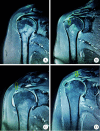[Association of increased greater tubercle angle and critical shoulder angle with rotator cuff tears]
- PMID: 40754913
- PMCID: PMC12330910
- DOI: 10.19723/j.issn.1671-167X.2025.04.018
[Association of increased greater tubercle angle and critical shoulder angle with rotator cuff tears]
Abstract
Objective: The greater tuberosity angle (GTA) and critical shoulder angle (CSA) are commonly referred to as radiographic markers which were used to described morphology of the greater tuberosity and acromion respectively. At present, most international studies focus on the correlation between the above two parameters and rotator cuff tears (RCTs), and their diagnostic value and risk assessment. This study attempts to find out the trend of GTA and CSA changes and risk threshold of RCTs, as well as the protective factors and risk factors.
Methods: In this study, 130 individuals from May 2019 to December 2020 were recruited. According to Southern California Orthopedic Institute (SCOI) classification, the individuals were divided into four groups retrospectively: Group A, negative control group; Group B, partial tears (articular side); Group C, partial tears (bursal side); Group D, full-thickness tears. GTA and CSA were measured respectively on true anteroposterior position X-ray of shoulder with arm in neutral rotation and performed by the same trained technician team in single-blind. The correlations between RCTs and relevant factors were analyzed.
Results: According to the area under the receiver operating characteristic curve (AUC), GTA and CSA of RCTs (Groups B, C and D) were 0.736 and 0.673 with 95% confidence interval (CI), the cut-off value of GTA and CSA of RCTs were 70.5° and 39.5° respectively. Comparing with the control group, RCTs groups had significant statistical differences in age and body mass index (BMI) (P < 0.05), especially the full-thickness RCTs (Group D), which was older than Groups A, B and C (P < 0.05, cut-off value: 56.5 years old) and shorter than Groups A and B (P < 0.05, cut-off value: 1.58 m). Analyzed from scatter plot and regression analysis, there was no linear correlation between GTA and CSA. There were no significant differences in gender, dominant shoulders and smoking between the RCTs groups and the control group (P>0.05).
Conclusion: Larger GTA (>70.5°) and CSA (>39.5°) would be highly predictive in diagnosing RCTs without linear correlation, and GTA has a higher diagnostic value in contrast. Subacromial impingement and shoulder degeneration occurred before RCTs. Patients with age >56.5 years and height < 1.58 m were more likely to develop disease of full-thickness RCTs and no statistic differences in weight and BMI. Gender, dominant shoulder and smoking were neither risk factors nor protective factors.
目的: 肱骨大结节角(greater tuberosity angle,GTA)和峰盂角(critical shoulder angle,CSA)通常作为影像学标记用于描述肱骨大结节和肩峰的形态,本研究分析肩袖撕裂患者GTA和CSA的变化趋势和风险阈值,并探讨肩袖撕裂的保护因素和危险因素。
方法: 从2019年5月至2020年12月共回顾性纳入130例患者,根据南加州骨科研究所(Southern California Orthopaedic Institute,SCOI)的分类法,将患者分为4组:A组,正常对照组;B组,部分肩袖撕裂(关节侧)组;C组,部分肩袖撕裂(滑囊侧)组;D组,全层肩袖撕裂组。在单盲条件下,由同一组医生分别在手臂中立位的肩胛骨正位X线片上测量GTA和CSA,分析其对肩袖撕裂的诊断价值,同时对可能影响肩袖撕裂的因素进行相关性分析。
结果: 根据受试者工作特征(receiver operating characteristic,ROC)曲线下面积(area under curve,AUC),在95%置信区间(confidence interval,CI)内,肩袖撕裂组(B、C、D组)的GTA和CSA分别为0.736和0.673,肩袖撕裂患者的GTA和CSA临界值(cut-off value)分别为70.5°和39.5°。与对照组相比,各肩袖撕裂组在身高、年龄、体重指数(body mass index,BMI)等方面差异均有统计学意义(P < 0.05),全层肩袖撕裂组(D组)患者的年龄更大(P < 0.05,临界值为56.5岁),比A、B组身高更低(P < 0.05,临界值为1.58 m)。散点图和回归分析显示,GTA与CSA之间不存在线性相关。与对照组相比,肩袖撕裂组在性别、优势肩和吸烟等方面差异无统计学意义(P>0.05)。
结论: 较大的GTA(>70.5°)和CSA(>39.5°)可能对诊断肩袖撕裂具有较高的预测价值,相较而言,GTA的诊断价值更高;年龄>56.5岁、身高 < 1.58 m的患者更易发生全层肩袖撕裂;性别、优势肩、吸烟既不是危险因素,也不是保护因素。
Keywords: Critical shoulder angle; Greater tuberosity angle; Rotator cuff tears; Shoulder impingement syndrome.
Conflict of interest statement
Figures






Similar articles
-
Magnetic resonance imaging, magnetic resonance arthrography and ultrasonography for assessing rotator cuff tears in people with shoulder pain for whom surgery is being considered.Cochrane Database Syst Rev. 2013 Sep 24;2013(9):CD009020. doi: 10.1002/14651858.CD009020.pub2. Cochrane Database Syst Rev. 2013. PMID: 24065456 Free PMC article.
-
Acquired Acromion Compromise, Including Thinning and Fragmentation, Is Not Associated With Poor Outcomes After Reverse Shoulder Arthroplasty.Clin Orthop Relat Res. 2024 Nov 1;482(11):2001-2013. doi: 10.1097/CORR.0000000000003131. Epub 2024 Jun 6. Clin Orthop Relat Res. 2024. PMID: 38843507
-
The effectiveness of diagnostic tests for the assessment of shoulder pain due to soft tissue disorders: a systematic review.Health Technol Assess. 2003;7(29):iii, 1-166. doi: 10.3310/hta7290. Health Technol Assess. 2003. PMID: 14567906
-
Is the Use of a Buprenorphine Transdermal Patch More Effective Than Oral Medications for Postoperative Analgesia After Arthroscopic Rotator Cuff Repair? A Randomized Clinical Trial.Clin Orthop Relat Res. 2025 May 1;483(5):857-865. doi: 10.1097/CORR.0000000000003303. Epub 2024 Nov 5. Clin Orthop Relat Res. 2025. PMID: 39499769 Clinical Trial.
-
Prescription of Controlled Substances: Benefits and Risks.2025 Jul 6. In: StatPearls [Internet]. Treasure Island (FL): StatPearls Publishing; 2025 Jan–. 2025 Jul 6. In: StatPearls [Internet]. Treasure Island (FL): StatPearls Publishing; 2025 Jan–. PMID: 30726003 Free Books & Documents.
References
-
- Neer CS. Anterior acromioplasty for the chronic impingement syndrome in the shoulder: A preliminary report. J Bone Joint Surg Am. 1972;54(1):41–50. - PubMed
-
- Bigliani LU, D' Alessandro DF, Duralde XA, et al. Anterior acromioplasty for subacromial impingement in patients younger than 40 years of age. Clin Orthop Relat Res. 1989;(246):111–116. - PubMed
-
- Cunningham G, Nicodeme-Paulin E, Smith MM, et al. The greater tuberosity angle: A new predictor for rotator cuff tear. J Shoulder Elbow Surg. 2018;27(8):1415–1421. - PubMed
-
- Kocadal O, Tasdelen N, Yuksel K, et al. Volumetric evaluation of the subacromial space in shoulder impingement syndrome. Orthop Traumatol Surg Res. 2022;108(2):103–110. - PubMed
-
- Bufe K, Müller KH, Retzlaff C, et al. Interobserver reliability of shoulder radiographic findings and correlation to MRI: A preliminary case series. Arch Orthop Trauma Surg. 2024;144(8):3313–3322. - PubMed
Publication types
MeSH terms
LinkOut - more resources
Full Text Sources
Medical
